RIKUZENTAKATA, Japan (Reuters) – Millions of people in Japan's devastated northeast were spending a fourth night without water, food or heating in near-freezing temperatures, as tens of thousands of rescue workers struggled to reach them.
As bodies washed up on the coast, injured survivors, children and elderly crammed into makeshift shelters, often without medicine. By Monday, 550,000 people had been evacuated after the earthquake and tsunami that killed at least 10,000.
The humanitarian crisis was unfolding on multiple fronts -- from a sudden rise in newly orphaned children to shortages of water, food, fuel and electricity to overflowing toilets in overwhelmed shelters and erratic care of traumatized survivors.
"It is the elderly who have been hit the hardest," said Patrick Fuller of the International Federation of Red Cross, in a memo written from Ishinomaki, one of several coastal cities brutalized by the swirling wall of waves.
"The tsunami engulfed half the town and many lie shivering uncontrollably under blankets. They are suffering from hypothermia having been stranded in their homes without water or electricity."
Local officials had lost contact with about 30,000 people, according to a survey by Kyodo News, raising concerns of a dramatic increase in the number of dead as authorities grapple with Japan's biggest emergency since World War Two.
Roads and rail, power and ports have been crippled across much of the northeast of Japan's main island Honshu, hampering relief efforts. The government has mobilized 100,000 soldiers to deliver food, water and fuel. Around 70 countries have offered assistance.
Hundreds of foreign rescue workers are assisting quake and tsunami victims but the United Nations does not plan to mount a bigger relief operation unless requested, U.N. aid officials said on Monday.
"EXHAUSTED BOTH PHYSICALLY AND MENTALLY"
"People are exhausted both physically and mentally," said Yasunobu Sasaki, the principal of a school converted into a shelter in Rikuzentakata, a nearly flattened village of 24,500 people in far-northern Iwate prefecture.
There was not enough food for three meals a day and no heating, he said. Sanitation was a also problem. His shelter has fewer than 10 temporary toilets and several makeshift wooden toilets with a hole in the ground.
"That's not enough for the around 1,800 people here," he said, adding medicine for the chronically ill was dwindling.
All along the ravaged northeastern coast, there were similar scenes of desperation and destruction. The wall of water transported homes inland, swept ships into fields, upended cars and left trains scattered across fields like toys.
Toshiyuki Suzuki, 61, has a heart pacemaker in his body and takes about seven kinds of medicine a day. He lost all of them when the waves swept away his home, along with his 91-year-old father and 25-year-old son.
He cannot go to hospitals because there is no gasoline at local fuel stations. "I am having problems with walking and with my heartbeat. I absolutely need medicine."
Emergency workers have so far rescued 15,000 people and about 550,000 had been evacuated by Monday to about 2,600 shelters in six prefectures, Kyodo said.
Snow or rain is expected on Wednesday in some regions, adding urgency to relief efforts.
(Writing by Jason Szep; Editing by Alex Richardson)



Tidak ada komentar:
Posting Komentar